The x86 Power Myth Busted: In-Depth Clover Trail Power Analysis
by Anand Lal Shimpi on December 24, 2012 5:00 PM ESTIdle Power
In all of these tests you're going to see three charts. The first will show you total platform power, measured at the battery, taking into account everything from SoC to display. The next shows you power measured at the CPU power delivery circuit, and the third shows you power measured at the GPU power delivery circuit. All values are measured in watts, and are reported in 15ms intervals (although I sampled at 1KHz then averaged down to 15ms).
For our first set of tests I simply wanted to get a feel for idle power. Both systems had all background syncing suspended, WiFi was connected, and we're just sitting at the Windows RT/8 Start Screen until the tablets reached a truly idle state. Note that idle under Windows RT/8 technically doesn't happen until the live tiles stop updating, which you'll see denoted by a drop in the idle power consumption in the graphs below.
First up is total platform power consumption:
Surface RT has higher idle power, around 28% on average, compared to Acer's W510. The last half of the graph shows the tablets hitting true idle when the live tiles stop animating.
A look at the CPU chart gives us some more granularity, with Tegra 3 ramping up to higher peak power consumption during all of the periods of activity. Here the Atom Z2760 cores average 36.4mW at idle compared to 70.2mW for Tegra 3.
The GPU specific data is pretty interesting - the GPU power rail shows much high power consumption than on Intel's Z2760. As I didn't design Tegra 3, I don't know what else is powered by this rail - although you'd assume that anything else not in use would be power gated. Imagination Technologies' PowerVR SGX 545 does appear to be quite power efficient here, on average using 155mW while rendering the Start Screen.
I wasn't happy with the peaks we were seeing when nothing was happening on the systems, so to confirm that nothing funny was going on I threw both tablets into airplane mode and waited for full idle. Check out the tail end of the platform power diagram:
That's much better. Without the AP talking to each tablet's WiFi radio constantly, idle becomes truly idle. If you're curious, the power savings are around 47.8mW (average) for the W510 in airplane mode when fully idle.
The GPU rail feeding the Atom Z2760 appears to hit a lower idle power when compared to NVIDIA's Tegra 3. Advantages in idle power consumption are key to delivering good battery life overall.


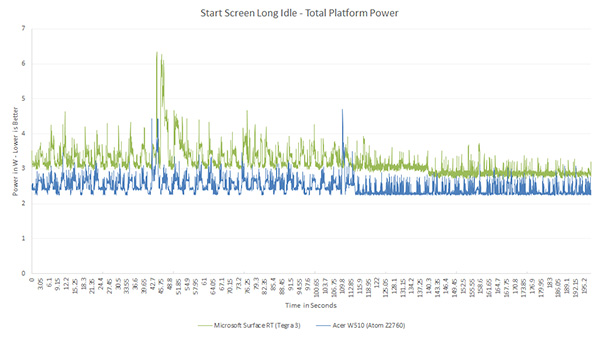
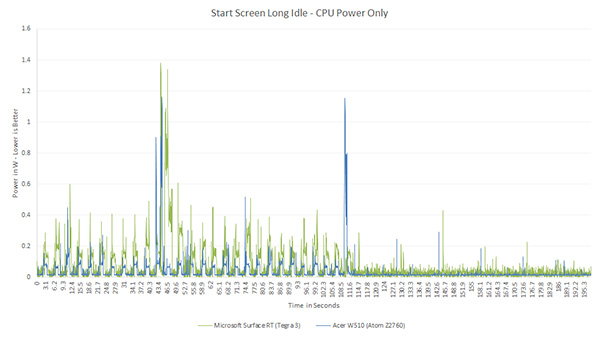
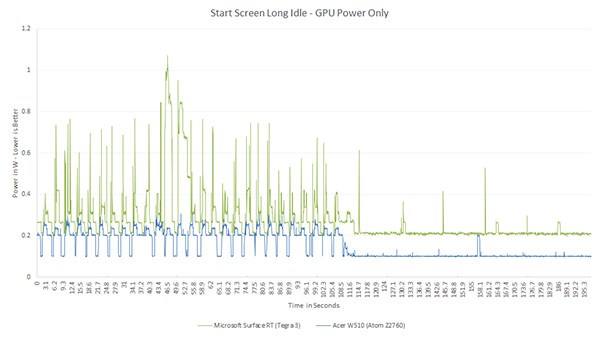

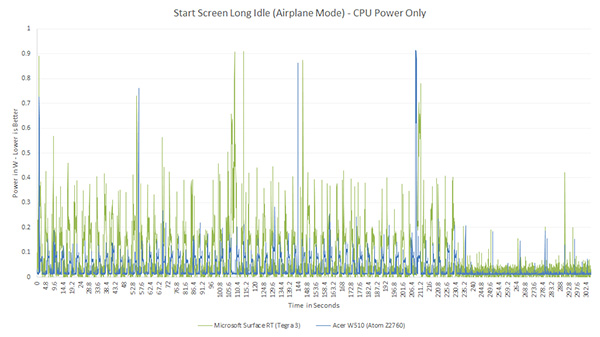
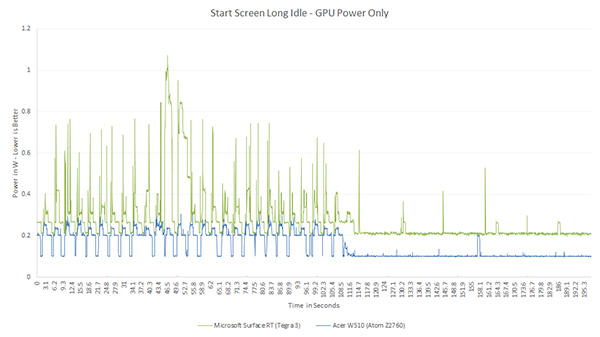








163 Comments
View All Comments
flashbacck - Monday, December 24, 2012 - link
"... Intel adopted a "no more surprises" policy... "What the F does that even mean? Don't build shitty products? Only upper management could come up with this genius policy.
magreen - Monday, December 24, 2012 - link
Now we had a chance to hear your comment, and boy you're just a straight shooter with upper management written all over you.lmcd - Tuesday, December 25, 2012 - link
Intel's philosophy pays off in Windows, for sure.Now, they've got Qualcomm to beat. That's going to take a bit more doing than beating a year-old chip.
lunarx3dfx - Tuesday, December 25, 2012 - link
I think several people misunderstood the purpose of this article. The purpose was to make the point clear that x86 could be performance/watt comparable to arm. Yes, clover trail is only beating a Tegra, but considering where Intel was only a year ago this looks promising. I don't see Anand being biased here, I see him making a point about power efficiency.coolhund - Tuesday, December 25, 2012 - link
Really? The x86 processor was an out of order architecture?Nope. Apples and oranges that way.
Gigaplex - Tuesday, December 25, 2012 - link
So what if it's not out of order? That's got nothing to do with the ISA. ARM could build an out of order chip if they wanted.coolhund - Tuesday, December 25, 2012 - link
The A9 is out of order, so is the A15. Thats not what I meant.yyrkoon - Tuesday, December 25, 2012 - link
The myth where ARM did perform more power efficiently than x86 before Intel starting caring ?Simple matter of the fact is that A9 does not encompass what ARM *is* (Neither does Tegra 3 for that matter ), and there are far more ARM based processors out in the world than Intel. This will likely continue into the foreseeable future. Simply because "ARM" is not locked into a specific market in the compute space.
Personally I am all for seeing Intel improve the power efficiency of their products. However, my own opinion is that Intel should either ditch atom, and improve their server, desktop, and mobile processors. And / or create another processor(s) that can decide on what it really wants to be. e.g. embedded application processor, or not.
One thing is for sure. Intel has their work cut out for them if they want to compete with ARM in the embedded market. One thing worth mentioning that is kind of ironic. x86 is supposed to be the general purpose type processor, yet the usage of various ARM based processor seem to be more diverse.
wsw1982 - Tuesday, December 25, 2012 - link
The atom want to be used in the smartphone and cheap tablet market, I think, at least now, Intel is quite clear about it. And it's very competitive now with the ARM solutions, so I don't see the reason why intel should abandon it along with the smartphone market. The core has been actually improved a lot and, to me, always the main focus of Intel.beginner99 - Tuesday, December 25, 2012 - link
... to compare to tegra 3. I think most would agree that comparing to dual-core A15 the outcome would be vastly different. But then I think we should not get fooled by Intel. As was mentioned this is still only a derivative of the original Atom on a smaller node. For Intel this is IMHO just a current placeholder. The real deal will come with the complete new uArch for Atom and if they manage to "pull off a Core 2" again (which I believe) it won't look pretty for Team ARM.